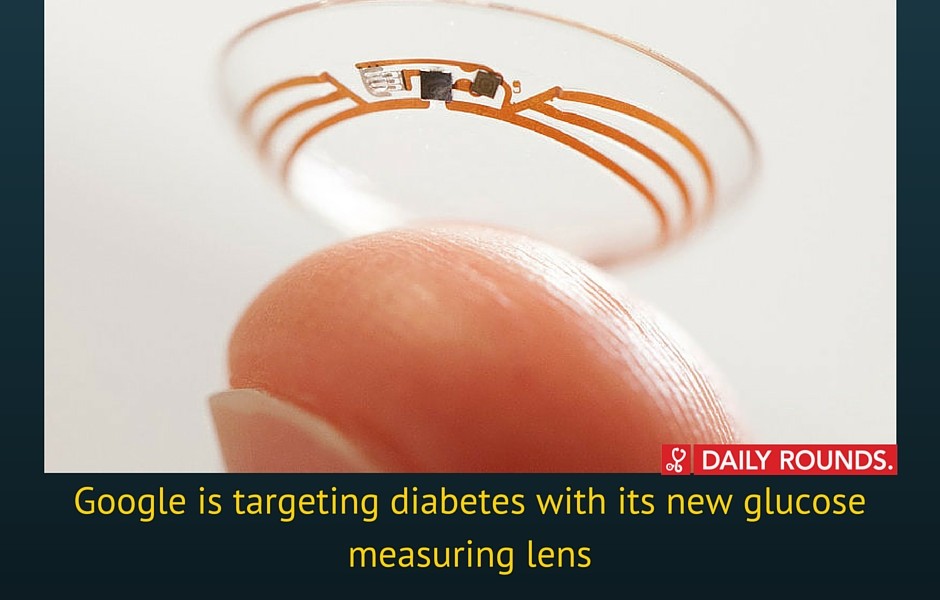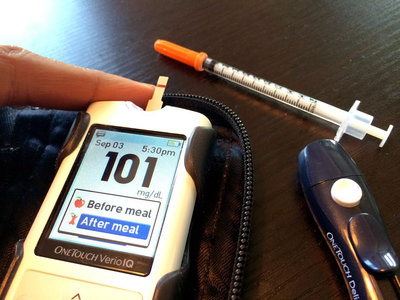
Google is targeting diabetes with its new glucose measuring lens
NPR news featured section ‘Shots’ talks about how Google’s Life Sciences division is taking on the challenge of making life for diabetes patients easier via its latest innovation – a glucose measuring contact lens.
Millions of people with diabetes prick a finger more than five times a day to monitor their blood glucose levels. It’s a painful and expensive process.Google Life Sciences spokeswoman Jacquelyn Miller confirms this in saying, “It’s really hard for people to manage their blood sugar. We’re hoping to take some of the guesswork out of it.”
The Google Life Sciences unit announced that diabetes is the company’s first major disease target. While it may come as a surprise that a company that helps people search online and dabbles in other ventures like self-driving cars, is investing in new therapies to treat disease, Michael Chae- Executive Director of the San Francisco Bay Area Chapter at the American Diabetes Association points out that Google’s decision is a no-brainer. It’s a highly lucrative opportunity. In 2012, the total cost of managing diabetes was put at $245 billion in the U.S. alone. The timing also appears just right for technology companies to enter the field.
“There’s been an explosion of wearables, data and analytics,” Chae said. “People with diabetes are more comfortable living in a measured world.” He sees a a future where people with diabetes can measure their blood glucose levels on a continuous basis, using painless methods. One of Google’s emerging products is a contact lens embedded with a glitter-sized sensor that can measure glucose levels in tears. “There’s a whole lot of innovation at once,” he said.
‘I Didn’t Feel like a Normal Human Being’
Cyrus Khambatta has been managing his Type 1 diabetes quite similarly for the past decade. A nutritionist by profession, he was diagnosed with the disease at 22. Each day he pricks his finger 6 to 10 times, draws a little blood, places it on a test strip and uses the glucose meter to check his blood sugar levels. Before meals and exercise he injects himself with insulin, with the amounts varying based on data from the glucose meter. The insulin required depends on factors like- stress, sleep, exercise and diet. It also involves a lot of attention to detail plus a little intuition. “Unlike a migraine or acne, diabetes management is all about developing an understanding and manipulation of numbers over time,” he said. “Diabetes is very quantitative.”

Many other people with diabetes use more modern alternatives for glucose monitoring, such as a patch with tiny needle-based sensors under the skin that connects to a transmitter and an insulin pump. Khambatta tried those options but he found those to be too complicated. The sensor needed to be changed every two to three days, and the equipment constantly reminded him of his medical condition. “I didn’t feel like a normal human being,” he said. He wished companies could develop non-invasive, continuous glucose monitoring, which wouldn’t draw blood or cause pain or trauma.
Why Google?
The life sciences team, which initially worked out of Google’s secretive research arm, Google X, spun out from the Google search engine business in August. Both entities will work under its recently launched umbrella organization Alphabet. The life sciences unit is led by molecular biologist Andy Conrad, who has helped the company secure partnerships with top drug makers and medical device companies. Conrad is ensuring the life sciences team works progressively and in the right direction by seeking help from more established players in the medical sector.
Google Life Sciences earlier this week announced a partnership with Sanofi, maker of an insulin inhaler and a slew of other products for people with diabetes and also with Novartis and Dexcom on diabetes-related projects.The diabetes market appears to be the primary focus for the internet search giant. Data and analytics is Google’s area of expertise, and as Miller puts it, diabetes management is fundamentally an “information problem.” As Khambatta put it, ‘Diabetes is very QUANTITATIVE’.
“Patients with diabetes lack clear information about how factors like nutrition and exercise affect their blood sugar levels”, she said. And these kind of insights could help them adjust their insulin levels and avoid serious outcomes, like stroke, heart disease and hypoglycemia. While the prospect of products like the lens sounds promising, one shouldn’t expect any of the products from the Life Sciences team to hit the market next week. Given the technical challenges and the regulatory requirements, experts say, it could take years before any new device reaches patients.
Edited from original post on – NPR Health Shots
Image Courtesy – Google, Cyrus Khambatta (for NPR Shots)

